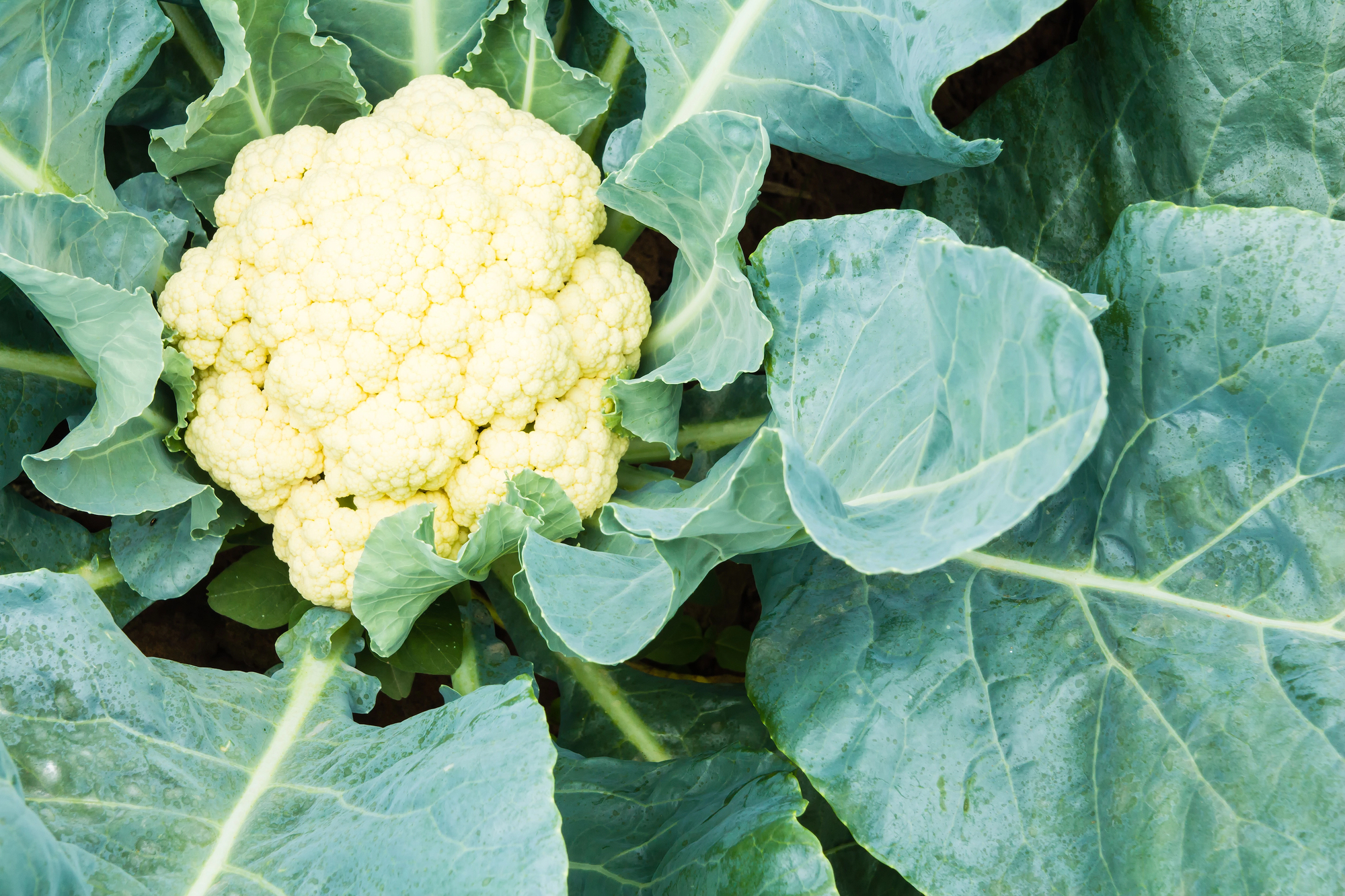Cauliflower Donation Tracker
Quick Links: How & Where to Grow | Temperature | How to Care For | Harvest Signs | Harvesting | Blanching | Pests | Companions | Varieties | Preservation | Recipes | Michigan Tips | Fun Facts
🌱 How & Where to Grow Cauliflower:
- Start indoors 4-6 weeks before last frost for spring crop.
- For fall crop (best in Michigan!), start seeds in June-July.
- Space plants 18-24 inches apart in rows 2-3 feet apart.
- Transplant when plants have 4-5 true leaves.
- Sunlight: Full sun (6+ hours) but appreciates afternoon shade in summer.
- Soil Type: Rich, well-drained soil with pH 6.0-7.0.
- Soil Amendment: Heavy feeder – needs nitrogen-rich, fertile soil.
Cauliflower is the fussiest brassica – it demands consistent conditions for perfect heads!
🌡️ Temperature Guidance:
Optimal 60-65°F. Bolts above 80°F. More sensitive than other brassicas.
- Best growth: Consistent 60-70°F temperatures.
- Spring challenge: Fluctuating temperatures cause buttoning (tiny heads).
- Heat stress: Above 80°F causes poor head formation or bolting.
- Frost tolerance: Mature plants tolerate light frost to 25°F.
- Needs 2 months of cool weather for proper head formation.
Michigan’s hot summers make fall cauliflower much more reliable than spring!
💧 How to Care for:
- Consistent Moisture: Critical – stress causes poor heads or buttoning.
- Watering: 1-1.5 inches weekly, never let dry out.
- Mulch: 3 inches to maintain even soil temperature and moisture.
- Fertilizer: Side-dress 3 weeks after transplanting with nitrogen.
- Steady growth: Any stress results in small or no heads!
📏 Harvest Signs:
Heads 6-8 inches, compact, white. Harvest before flowers separate.
- Size: Heads typically 6-8 inches diameter when ready.
- Appearance: Tight, compact curds with no separation.
- Color: Bright white (or appropriate color for variety).
- Timing critical: Can go from perfect to ricey in 2-3 days!
- Check daily once heads start forming – they mature quickly.
Unlike broccoli, cauliflower won’t produce side shoots – you get one chance!
🧺 Harvesting:
Cut deep with sharp knife. Leave wrapper leaves for protection. Morning harvest best.
- Cut 4-6 inches below head to include protective leaves.
- Handle carefully – heads bruise easily.
- Harvest promptly – overripe heads become ricey and bitter.
- One shot: Unlike broccoli, no secondary harvest.
- Cool quickly for best quality and storage.
🌿 Blanching:
Tie leaves over head when 2-3 inches diameter. Self-blanching varieties available.
- When: Start when heads are egg-sized (2-3 inches).
- Method: Gather outer leaves and tie with soft twine or rubber band.
- Purpose: Protects from sun to maintain white color.
- Check often: Heads mature 7-12 days after tying.
- Alternative: Choose self-blanching varieties with leaves that naturally curl.
🪲 Michigan Pests:
Cabbage worms, aphids, flea beetles, clubroot.
- Cabbage worms: Most common – use Bt spray or row covers.
- Aphids: Gray-green clusters in heads – blast with water.
- Flea beetles: Tiny holes in leaves – use row covers on young plants.
- Clubroot: Soil disease – rotate crops, maintain pH above 7.0.
- Black rot: V-shaped yellowing – remove affected plants.
🫱🏽🫲🏼 Companions:
Good with onions, garlic, dill, chamomile. Avoid strawberries, tomatoes.
- Onions and garlic: Repel many brassica pests.
- Dill: Attracts beneficial wasps that prey on cabbage worms.
- Nasturtiums: Trap crop for aphids.
- Avoid strawberries: Compete for nutrients.
- Keep away from: Other brassicas to prevent disease spread.
🥦 Varieties:
‘Snow Crown’, ‘Amazing’, ‘Cheddar’, ‘Graffiti’, ‘Romanesco’.
- ‘Snow Crown’: 50 days, early, heat tolerant, self-blanching.
- ‘Amazing’: 75 days, large heads, good for fall.
- ‘Cheddar’: 80 days, orange heads high in beta-carotene.
- ‘Graffiti’: 80 days, purple heads, no blanching needed.
- ‘Romanesco’: 85 days, spiral fractals, nutty flavor.
🫙 Preservation:
Freeze blanched 3 minutes. Pickle. Fresh 1-2 weeks.
- Fresh storage: Wrap in plastic, refrigerate 1-2 weeks.
- Freezing: Cut florets, blanch 3 minutes, cool, freeze.
- Pickling: Makes excellent pickled vegetables.
- Dehydrating: Rice first, then dehydrate for “cauliflower rice.”
- Not recommended: Canning turns mushy.
🧑🏽🍳 Recipes:
Roasted cauliflower, cauliflower rice, buffalo cauliflower, mashed cauliflower.
- Whole roasted cauliflower with tahini sauce.
- Cauliflower rice – low-carb alternative to grain.
- Buffalo cauliflower “wings” for game day.
- Creamy cauliflower soup with sharp cheddar.
- Indian aloo gobi (cauliflower and potato curry).
✋🏼 Michigan Tips:
- Fall crops far superior to spring in Michigan!
- Start fall crop in late June for October harvest.
- Use row covers entire season for pest control.
- Michigan’s variable spring weather causes buttoning.
- Choose quick-maturing varieties for spring attempt.
- Raised beds help with temperature consistency.
🧠 Fun Facts:
- Cauliflower is actually an undeveloped flower head!
- Originally came in colors – white was selectively bred.
- The word means “cabbage flower” in Italian.
- One cup has 77% of daily vitamin C needs.
- Romanesco cauliflower displays perfect Fibonacci spirals.
- Mark Twain called it “cabbage with a college education.”
- Orange cauliflower has 25x more vitamin A than white.
- Purple varieties contain the same antioxidants as red wine!


0 Comments